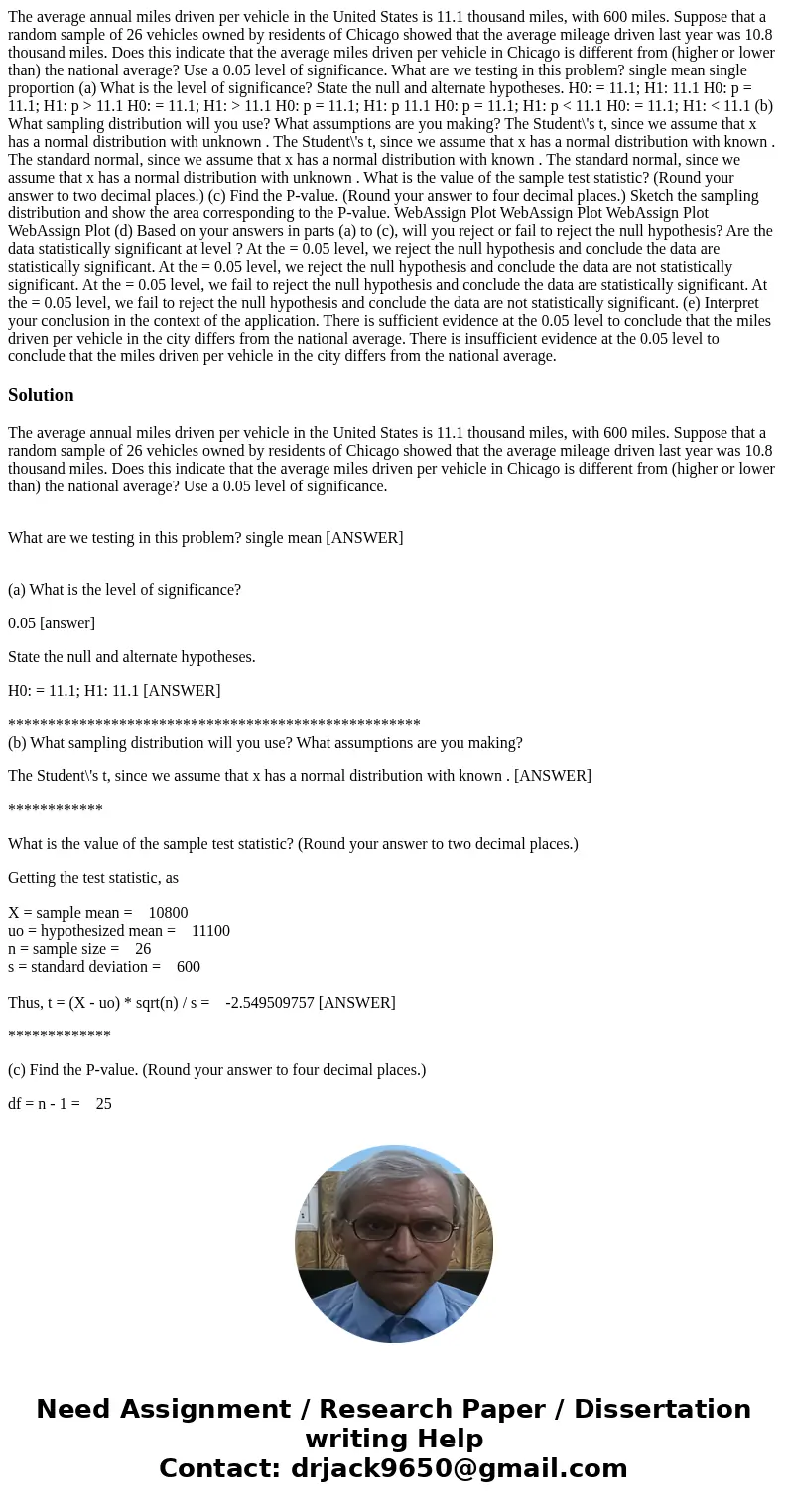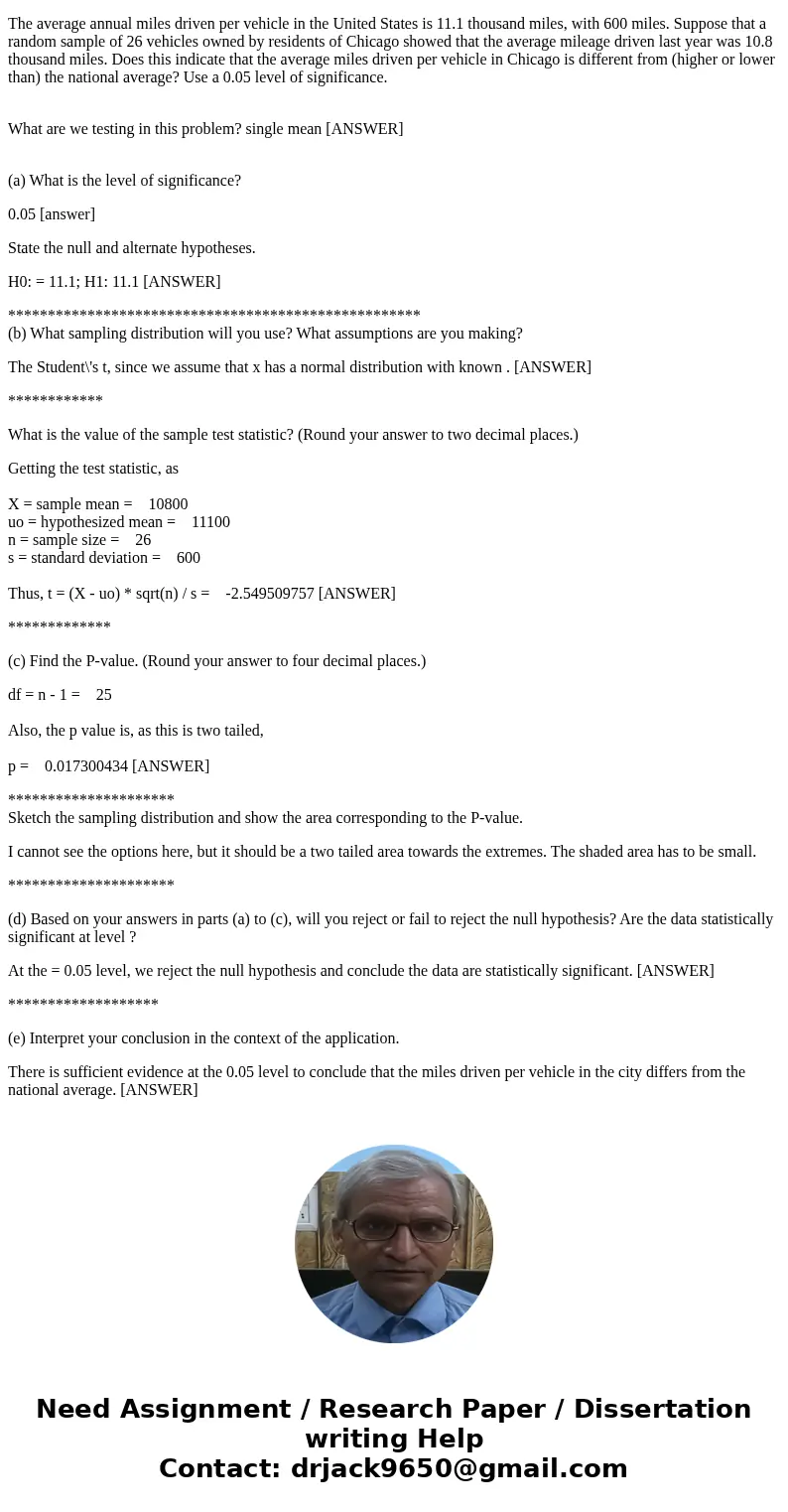The average annual miles driven per vehicle in the United St
The average annual miles driven per vehicle in the United States is 11.1 thousand miles, with 600 miles. Suppose that a random sample of 26 vehicles owned by residents of Chicago showed that the average mileage driven last year was 10.8 thousand miles. Does this indicate that the average miles driven per vehicle in Chicago is different from (higher or lower than) the national average? Use a 0.05 level of significance. What are we testing in this problem? single mean single proportion (a) What is the level of significance? State the null and alternate hypotheses. H0: = 11.1; H1: 11.1 H0: p = 11.1; H1: p > 11.1 H0: = 11.1; H1: > 11.1 H0: p = 11.1; H1: p 11.1 H0: p = 11.1; H1: p < 11.1 H0: = 11.1; H1: < 11.1 (b) What sampling distribution will you use? What assumptions are you making? The Student\'s t, since we assume that x has a normal distribution with unknown . The Student\'s t, since we assume that x has a normal distribution with known . The standard normal, since we assume that x has a normal distribution with known . The standard normal, since we assume that x has a normal distribution with unknown . What is the value of the sample test statistic? (Round your answer to two decimal places.) (c) Find the P-value. (Round your answer to four decimal places.) Sketch the sampling distribution and show the area corresponding to the P-value. WebAssign Plot WebAssign Plot WebAssign Plot WebAssign Plot (d) Based on your answers in parts (a) to (c), will you reject or fail to reject the null hypothesis? Are the data statistically significant at level ? At the = 0.05 level, we reject the null hypothesis and conclude the data are statistically significant. At the = 0.05 level, we reject the null hypothesis and conclude the data are not statistically significant. At the = 0.05 level, we fail to reject the null hypothesis and conclude the data are statistically significant. At the = 0.05 level, we fail to reject the null hypothesis and conclude the data are not statistically significant. (e) Interpret your conclusion in the context of the application. There is sufficient evidence at the 0.05 level to conclude that the miles driven per vehicle in the city differs from the national average. There is insufficient evidence at the 0.05 level to conclude that the miles driven per vehicle in the city differs from the national average.
Solution
The average annual miles driven per vehicle in the United States is 11.1 thousand miles, with 600 miles. Suppose that a random sample of 26 vehicles owned by residents of Chicago showed that the average mileage driven last year was 10.8 thousand miles. Does this indicate that the average miles driven per vehicle in Chicago is different from (higher or lower than) the national average? Use a 0.05 level of significance.
What are we testing in this problem? single mean [ANSWER]
(a) What is the level of significance?
0.05 [answer]
State the null and alternate hypotheses.
H0: = 11.1; H1: 11.1 [ANSWER]
****************************************************
(b) What sampling distribution will you use? What assumptions are you making?
The Student\'s t, since we assume that x has a normal distribution with known . [ANSWER]
************
What is the value of the sample test statistic? (Round your answer to two decimal places.)
Getting the test statistic, as
X = sample mean = 10800
uo = hypothesized mean = 11100
n = sample size = 26
s = standard deviation = 600
Thus, t = (X - uo) * sqrt(n) / s = -2.549509757 [ANSWER]
*************
(c) Find the P-value. (Round your answer to four decimal places.)
df = n - 1 = 25
Also, the p value is, as this is two tailed,
p = 0.017300434 [ANSWER]
*********************
Sketch the sampling distribution and show the area corresponding to the P-value.
I cannot see the options here, but it should be a two tailed area towards the extremes. The shaded area has to be small.
*********************
(d) Based on your answers in parts (a) to (c), will you reject or fail to reject the null hypothesis? Are the data statistically significant at level ?
At the = 0.05 level, we reject the null hypothesis and conclude the data are statistically significant. [ANSWER]
*******************
(e) Interpret your conclusion in the context of the application.
There is sufficient evidence at the 0.05 level to conclude that the miles driven per vehicle in the city differs from the national average. [ANSWER]


 Homework Sourse
Homework Sourse